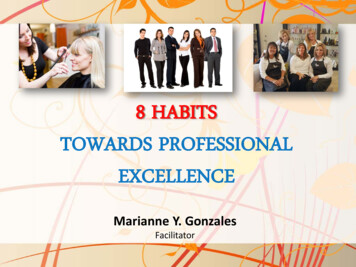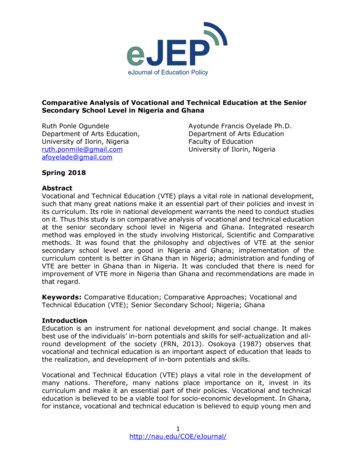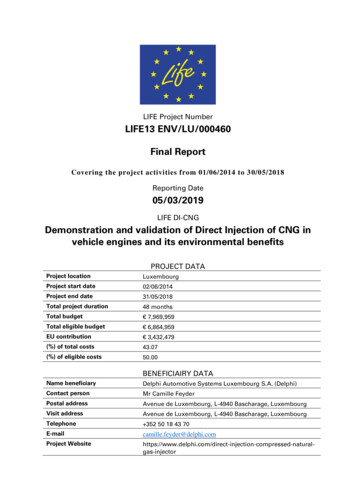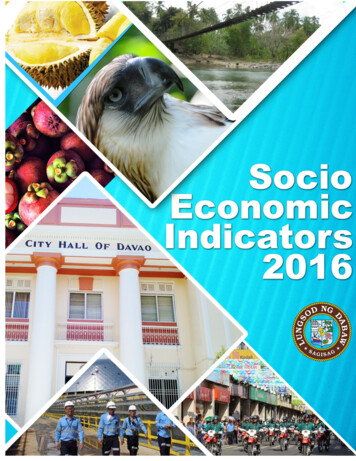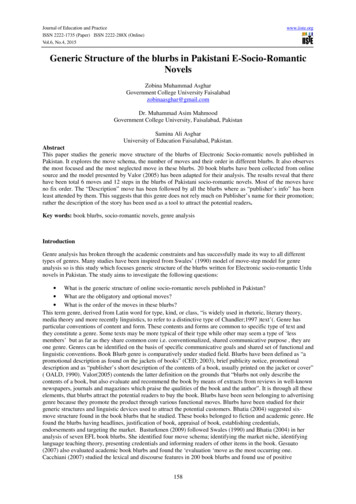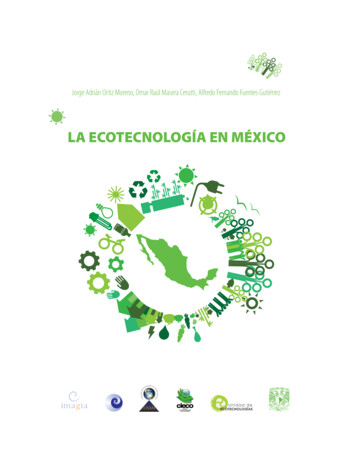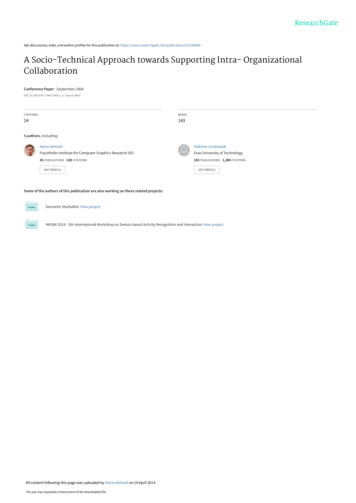
Transcription
See discussions, stats, and author profiles for this publication at: A Socio-Technical Approach towards Supporting Intra- OrganizationalCollaborationConference Paper · September 2008DOI: 10.1007/978-3-540-87605-2 4 · Source: DBLPCITATIONSREADS141435 authors, including:Mario AehneltStefanie LindstaedtFraunhofer Institute for Computer Graphics Research IGDGraz University of Technology35 PUBLICATIONS 139 CITATIONS153 PUBLICATIONS 1,200 CITATIONSSEE PROFILESEE PROFILESome of the authors of this publication are also working on these related projects:Semantic MediaWiki View projectiWOAR 2018 - 5th international Workshop on Sensor-based Activity Recognition and Interaction View projectAll content following this page was uploaded by Mario Aehnelt on 24 April 2014.The user has requested enhancement of the downloaded file.
A Socio-Technical Approach towards Supporting IntraOrganizational CollaborationIn:Times of Convergence. Technologies Across Learning Contexts. Proceedings (2008) pp. 33 - 38 2008 Springer-VerlagMario Aehnelt1, Mirko Ebert1, Günter Beham2,3, Stefanie Lindstaedt2,3, Alexander Paschen11Fraunhofer Institute for Computer Graphics RostockJoachim-Jungius-Strasse 11, 18059 Rostock, Germany{mario.aehnelt, dgasse 21a, 8010 Graz, Austria{gbeham, slind}@know-center.at3Knowledge Management Institute, Graz University of TechnologyInffeldgasse 21a, 8010 Graz, AustriaAbstract:Knowledge work in companies is increasingly carried outby teams of knowledge workers. They interact within andbetween teams with the common goal to acquire, apply,create and share knowledge. In this paper we propose asocio-technical model to support intra-organizational collaboration which specifically takes into account the socialand collaborative nature of knowledge work. Our aim is tosupport in particular the efficiency of collaborative knowledge work processes through an automated recommendation of collaboration partners and collaboration media. Wereport on the theoretical as well as practical aspects of sucha socio-technical model.Keywords: collaboration, media selection, knowledgework, recommender system1 IntroductionIn times of information overload, acceleration of all lifeareas and world-wide globalization today’s companies needhighly qualified and motivated employees who are able tohandle information efficiently and transfer them continuously into innovation. These knowledge workers are specialists. They have the relevant knowledge about facts,concepts, relations and methods of their working domain ordiscipline. With their ability to continuously acquire andapply theoretical as well as analytical knowledge, knowlWith kind permission of Springer Science Business MediaSelected Readings in Computer Graphics 2008edge workers are the most valuable capital of innovationcentered companies. In their self-conscious social role asspecialists they are even willing to voluntarily share theirknowledge out of moral obligation and community interest[1].In parallel today’s companies are looking for new strategiesto gain access to and utilize highly qualified and motivatedknowledge workers in order to increase the efficiency ofknowledge work and to manage the continuously growingcomplexity of information, processes and resources. Theirmajor challenge is to turn this hidden capital of knowledgeworkers into innovation as efficiently as possible.With this paper, we want to present a socio-technical approach for supporting knowledge workers as contributors tocollaborative communities in work-integrated learning. Thisapproach is being developed as part of the APOSDLE project 1.2 Supporting Collaborative CommunitiesCollaborative communities are built up and growingthrough social interactions between knowledge workerswith the common purpose to acquire, apply, create or share1Thegoal of APOSDLE (http://www.aposdle.org) is to enhance the productivity of knowledge workers by supporting informal learning activities in thecontext of knowledge workers’ everyday work processes and within their workenvironments.375
A Socio-Technical Approach towards Supporting Intra-Organizational Collaboration 2008 Springer-Verlagknowledge. These social interactions can be divided intointeractions related to other knowledge workers and interactions related to knowledge, e.g. they create, use, comment,rate, discuss, tag knowledge or they communicate, collaborate, rate, comment or tag on each other. All interactionscreate new knowledge by externalization (tacit to explicit),internalization (explicit to tacit) and combination (explicitto explicit) of knowledge [2]. With our approach we want toincrease the efficiency of knowledge creation in collaborative communities and support their social interactions. Thuswe propose two ways of socio-technical support: recommendation of collaboration partners and recommendationof adequate collaboration channels and tools. Both waysare described in following sub sections.2.1. Recommendation of CollaborationPartnersBefore collaborations actually take place knowledge workers may ask themselves a question like “Who of my colleagues could help me with the work I’m currently doing?”To support knowledge workers in answering questions likethis, recommendation of collaboration partners is the firststep of our socio-technical support. In APOSDLE recommendations are based on the work context learning model[3]. The aim is to recommend for a knowledge worker (i.e.knowledge seeker) a set of knowledgeable persons (i.e.possible collaboration peers) adopting the expert role. Tofind them, APOSDLE maintains user profiles [4] based on amulti-layered overlay user model. From the user modelperspective its structure shows similarities to the ELM-ARTsystem described in [5]. APOSDLE’s recommender systemcan also be classified according to [6] as knowledge basedrecommendation system because it heavily depends onknowledge about the users modeled beforehand.The work layer of the user model is the basis for calculatingrecommendations of collaboration partners. It describes alltasks and work processes a knowledge worker has donewhile using the APOSDLE system. The work layer of theuser profile is continuously updated with usage data as theknowledge worker interacts with the system.The recommender system uses a learning need analysis asdescribed in [3] as the foundation to calculate a knowledgeseeker’s learning need as well as knowledgeable persons.All found persons are then ranked based on how often theyhave gained competencies covering the learning need. Atthe end of this process a ranked list of knowledgeable persons has been generated which then will be presented to theknowledge seeker.2.2. Recommendation of CollaborationMediaIn real-world - especially in computer-mediated - collaboration scenarios the selection of a collaboration tool 2 is mostlynot reflected. Knowledge workers use the tool they like bestor the tool everybody use or the tool provided by the organization or company. Very often the tool finally selectedfor computer-supported collaboration is not at all appropriate with regard to the task to be performed, the collaboration context and the collaboration partners. If we try toimprove the performance of knowledge workers, we have toreview this part of collaboration.The research field of media selection provides a variety ofdifferent theories: trait theories (social presence theory [7],task-oriented media selection [8], media richness theory [9]and task closure theory [10]), social interaction theories(symbolic interactionist perspective [11], social influencemodel [12] and critical mass theory [13]), experience-basedmedia appropriateness (technology acceptance model [14],channel expansion theory [15] and effects media appropriateness [16]) as well as theories considering group dynamics (media synchronicity theory [17]).All these theories try to describe the user behavior regardingmedia selection. If we analyze the different media selectionapproaches considering experienced knowledge workerswith individual preferences, we come to following keyconclusions:-Most approaches consider media selection from theperspective of a collaboration initiator only. The perspective of the cooperation partner is completely leftout.-Some approaches are focused on external conditionsinfluencing media selection while personal conditionsare left out (e.g. critical mass theory [11]).Based on the critical observations [18][19] we design amedia selection model that combines the strengths of different media selection theories like technology acceptancemodel, channel expansion theory, critical mass theory, social influence theory or social interaction perspective. Ourmedia selection model for intra-organizational collaboration (see Fig. 1) provides an approach towards recommending and pre-selecting collaboration tools for a certain workor learning context. Therefore our model takes into account2We use the term tool when describing a software application that provides thefunctionality to interact via a certain medium. Medium refers here to a certaincommunication transfer channel which stores and delivers information or databetween sender and receivers.376Systems and Architecture
A Socio-Technical Approach towards Supporting Intra-Organizational Collaboration 2008 Springer-Verlagthree elementary influence factors: knowledge seeker,knowledgeable person and collaborative community.With this combination of collaboration profile and experience based recommendation of collaboration media, wesupport the technical aspect of social interactions within acollaborative community as well as increase the efficiencyin working with knowledge.3 Conclusions and Future WorkFig. 1. Influence factors of media selection model forintra-organizational collaborationOn the knowledge seeker’s side we differentiate the factorsworking task (complexity and information spreading), collaboration context (time pressure, time to answer and location) and collaboration experiences (personal perspectiveand experiences of the knowledge seeker from earlier collaborations with a knowledgeable person). The knowledgeable person also has an own collaboration context. In addition, both knowledge seeker and knowledgeable persons areinfluenced by their individual media experience. This factorreflects the personal experiences with collaboration mediaand tools of each collaboration partner. We also need toconsider further environmental influences which affectmedia selection at both ends: social environment mediaexperiences (media experiences of a team, department orother communities) and the companies media demand (media experiences of the company or organization). The objective media properties (richness, feedback time, synchronicity, re-use etc.) go only indirectly into the model. Theyinfluence the individual media experience.Beside other factors our approach focuses in particular onthe medium experiences and preferences of the individualand their social context – for example their collaborativecommunity. Thus it requires in depth knowledge aboutthese experiences and preferences to allow a technicalmeaningful implementation.The media experience of knowledge workers can be derivedfrom their collaboration history. But without having initialhistory information our approach would not be able to produce meaningful recommendations. Therefore we combinedthis method with a straightforward collaboration profilebased media recommendation taking the collaborationprofiles of knowledge seeker as well as knowledgeablepersons into account.Selected Readings in Computer Graphics 2008With this paper we proposed a socio-technical approachtowards supporting collaborative communities of knowledge workers and motivating them to actively participate inorganizational knowledge comunities. We aim to supportthem technically through recommending adequate collaboration partners and recommending suitable collaborationmedia and tools. We described a media selection model thatis based on media experiences and the knowledge workerscontext. An important feature of our model is that we notonly considered the knowledge seeker but also the othercollaboration partners (knowledgeable persons) and theirsocial context. The model combines experience-based factors and objective media properties influenced factors. Another advantage of the proposed model is its robustness andthe simplicity. Thus if one factor in the model is missing thealgorithm still calculates meaningful values.The next step towards a verification of our proposed modelwill be a larger evaluation within the APOSDLE context.This evaluation comprises a comparison of model less media selection with our proposed model. In parallel we willanalyze reasonable indicators for the efficiency of knowledge work in collaborative communities.For the recommendation system of APOSDLE we plan toextend and refine the user model by integrating knowledgeindication events. This new type of events will be collectedin the learning space of the 3spaces model.AcknowledgementsAPOSDLE (www.aposdle.org) has been partially fundedunder grant 027023 in the IST work programme of theEuropean Community. The Know-Center is funded withinthe Austrian COMET Program - Competence Centers forExcellent Technologies - under the auspices of the AustrianMinistry of Transport, Innovation and Technology, theAustrian Ministry of Economics and Labor and by the Stateof Styria. COMET is managed by the Austrian ResearchPromotion Agency FFG.References[1] Fahey, Richard; Vasconcelos, Ana C.; Ellis, David :The Impact of Rewards Within Communities of Practice: A Study of The SAP Online Global Community.377
A Socio-Technical Approach towards Supporting Intra-Organizational Collaboration 2008 Springer-VerlagIn: Knowledge Management Research and Practice, 5,pp. 186–198 (2007)[2] Nonaka, Ikujiro: A Dynamic Theory of OrganizationalKnowledge Creation. In: Organization Science, vol.5,no. 1, pp. 14–37 (1994)[3] Ley, T., Kump, B., Ulbrich, A. Scheir, P., and Lindstaedt, S. N.: A Competence-Based Approach for Formalizing Learning Goals in Work-Integrated Learning.Proceedings of the ED-MEDIA 2008--World Conference on Educational Multimedia, Hypermedia & Telecommunications, Vienna, (2008)[4] Montaner, M., López, B. & De la Rosa, J. L.: A Taxonomy of Recommender Agents on the Internet, in:Artificial Intelligence Review, 19, 4, 285-330 (2003)[5] Weber, G. & Brusilovsky, P.: ELM-ART: An AdaptiveVersatile System for Web-based Instruction. International Journal of Artificial Intelligence in Education(JAIED), 12, 4, 351-384 (2001)[6] Burke, R.: Hybrid Recommender Systems: Survey andExperiments. User Modeling and User-Adapted Interaction 12, 4, 331-370 (2002)[7] Short, John; Williams, Ederyn; Christie, Bruce: TheSocial Psychology of Telecommunications. London:John Wiley & Sons (1976)[14] Davis, F.D. A Technology Acceptance Model for Empirically Testing New End-User Information Systems:Theory and Results. Doctoral Dissertation. Sloan Management School, Massachusetts Institute of Technology (1986)[15] Carlson, J.R.; Zmud, R.W.: Channel Expansion Theory: A Dynamic View of Media and Information Richness Perceptions. Academy of Management Conference Proceedings. Dallas, Texas, pp. 91–105 (1994)[16] Carlson, J.R.; Zmud, R.W.: Channel Expansion Theoryand the Experimental Nature of Media Richness Perceptions. In: Academy of Management Journal, vol.42, no. 2, pp. 153–170 (1999)[17] King, R.; Xia, W.: Media Appropriateness: Effects ofExperience on Communication Media Choice. In: Decision Sciences, vol. 28, no. 4, pp. 877–910 (1997)[18] Dennis, A.; Valacich, J.: Rethinking Media Richness:Towards a Theory of Media Synchronicity. In: Sprague, R.H. (eds.): Proceedings of the 32th Hawaii International Conference on Systems Sciences. Los Alamitos, California: IEEE (1999)[19] Weber, A.: Medienwahl - Eine Auswertung von Ergebnissen der empirischen Forschung. Zürich: Universität Zürich (2003)[8] Reichwald, Ralf; Möslein, Kathrin; Sachenbacher,Hans: Telekooperation: verteilte Arbeits- und Organisationsformen. Berlin: Springer (2000).[9] Treviño, Linda K.; Lengel, Robert H.; Daft, RichardL.: Media Symbolism, Media Richness, and MediaChoice in Organizations: A Symbolic InteractionistPerspective. In: Communication Research, vol. 14,no.5, pp. 553–574 (1987)[10] Straub, D.; Karahanna, E.: Knowledge Worker Communications and Recipient Availability: Towards aTask Closure Explanation of Media Choice. In: Organization Science, vol. 9, no. 2. (1998)[11] Treviño, Linda K.; Lengel, Robert H.: The RichnessImperative and Cognitive Style: The Role of IndividualDifferences in Media Choice and Behavior. In: Management Communication Quarterly, vol. 4, no. 2, pp.176–197 (1990)[12] Fulk, J.; Steinfield, C. W. (eds.): Organizations andCommunication Technology. Newbury: Sage Publications (1990)[13] Markus, M. L.: Electronic Mail as the Medium ofManagerial Choice. In: Organization Science, vol. 5,no. 4,ppS. 502–527 (1994)378View publication statsSystems and Architecture
leagues could help me with the work I'm currently doing?" To support knowledge workers in answering questions like this, recommendation of collaboration partners is the first step of our socio-technical support. In APOSDLE recom-mendations are based on the work context learning model [3]. The aim is to recommend for a knowledge worker (i.e.

